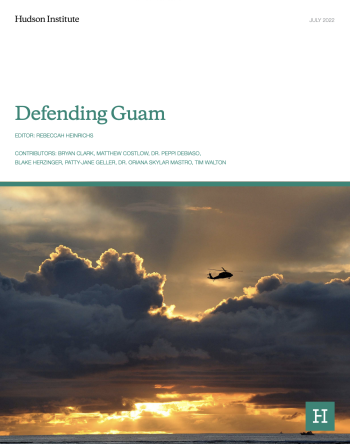Defense, Deterrence, and the Role of Guam
Defense, Deterrence, and the Role of Guam
An essay in a Hudson Institute report, Defending Guam, edited by Rebeccah Heinreichs

Guam, “where America’s day begins,” constitutes an indispensable strategic hub for the United States. The largest of the Mariana Islands in the western Pacific, it allows the United States to successfully project power within the Indo-Pacific region and so makes credible US security commitments to key US allies located there. Guam is home to Andersen Air Force Base (AFB), from which F-22 Raptors and strategic bomber rotations project US power from the skies, and to the deep-water port Apra Harbor, which plays a critical role in US Navy missions aimed at keeping trade routes open. Thus, this US territory is essential to the security of the American citizenry.
Maintaining a free and open Indo-Pacific theater constitutes a vital US interest and a necessity for the credible provision of US assurances and commitments to key US allies in the region. These US security guarantees, backed by US resolve and military power, underpin the US-led order regionally and globally. Moreover, not only is Guam a key strategic hub and so vital to American security and prosperity, but it is also a US territory and home to US citizens. Guam’s defense is therefore imperative. Fighting from and for Guam is challenging but eminently achievable, and its defenses must be strengthened now to dissuade the PRC from initiating aggressions against it in pursuit of one of its national priorities, the conquest of a democratic Taiwan. However, time is not on our side, and we must therefore move quickly.
Given Guam’s strategic importance and the threat to its security that the PRC represents, the US has a clear and vital national interest and an obligation to ensure Guam’s protection. Therefore, inspiring and contributing to public consideration of and debate about the importance of Guam’s defense is essential. Mastro's paper is part of a Hudson Institute collection of essays, Defending Guam, that contributes to this endeavor. In them, scholars who have devoted research and analysis to difficult challenges facing policymakers and defense planners and who represent a wide range of knowledge, expertise, and diverse viewpoints address various aspects of the PRC challenge and suggest approaches to address Guam’s vulnerability. These scholars agree on some key aspects of the threat the PRC poses and the consequent challenge facing the United States but at times emphasize varying aspects of the challenge and propose differing orders of priority in meeting these challenges.
